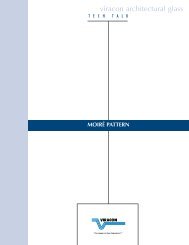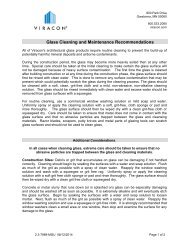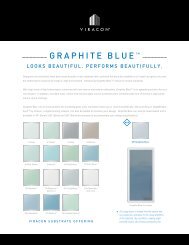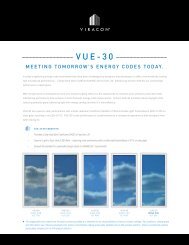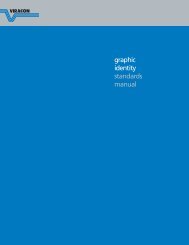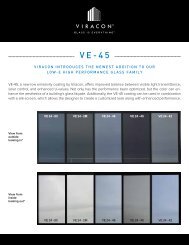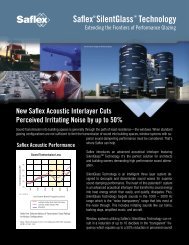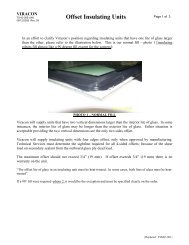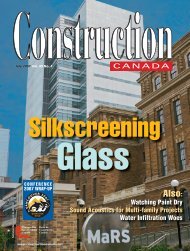bird friendly glass - Viracon
bird friendly glass - Viracon
bird friendly glass - Viracon
You also want an ePaper? Increase the reach of your titles
YUMPU automatically turns print PDFs into web optimized ePapers that Google loves.
®<br />
<br />
T E C H T A L K<br />
BIRD FRIENDLY GLASS
BIRD FRIENDLY GLASS<br />
When designing buildings with <strong>bird</strong> safety in mind, it<br />
is important to understand that <strong>bird</strong>s do not perceive<br />
<strong>glass</strong> as an obstacle to their flight path. To aid in reducing<br />
collisions, the lighting of the <strong>glass</strong>, elements<br />
placed near the <strong>glass</strong> as well as the <strong>glass</strong> selection<br />
itself must all be considered.<br />
Multiple organizations are involved in researching the<br />
ability of <strong>bird</strong>s to perceive <strong>glass</strong> and what can be done<br />
to help mitigate <strong>bird</strong> collisions with <strong>glass</strong> facades. The<br />
increased awareness has lead organizations such as<br />
the New York City Audubon Society and Audubon<br />
Minnesota to develop <strong>bird</strong> safe building guidelines. It<br />
is also driving some cities and states to pass laws and<br />
develop official standards, such as the <strong>bird</strong>-safe ordinance<br />
in Cook County, IL and San Francisco Planning<br />
Commission’s Bird Safe Building Standards, passed in<br />
July 2011.<br />
<strong>Viracon</strong>’s Involvement<br />
As a <strong>glass</strong> fabricator, <strong>Viracon</strong> has been actively involved<br />
in on-going research to understand the effect<br />
of various <strong>glass</strong> products and their potential to reduce<br />
<strong>bird</strong> strikes. To date, our focus has been finding practical<br />
solutions using conventional <strong>glass</strong> products and<br />
enhancements to these products.<br />
Silk-screened Glass<br />
Control Glass<br />
Tested Products<br />
All <strong>glass</strong> products tested were 1” Insulating units. The<br />
outboard <strong>glass</strong> ply was ¼” clear <strong>glass</strong> with the silkscreen<br />
pattern applied to the second surface, <strong>Viracon</strong>’s<br />
VE-2M low emissivity coating applied over the<br />
silk-screen pattern, a ½” air space and ¼” clear <strong>glass</strong><br />
inboard. The control unit for testing was the identical<br />
<strong>glass</strong> construction as listed above, excluding any silkscreen<br />
pattern.<br />
<strong>Viracon</strong> provided a number of insulating <strong>glass</strong> units<br />
used for field testing during <strong>bird</strong> migration in the fall<br />
of 2010. The primary objective was to test the effectiveness<br />
of silk-screen patterns as a means of mitigating<br />
<strong>bird</strong> collisions with <strong>glass</strong>. The field testing was<br />
designed by the American Bird Conservancy (ABC) –<br />
Washington, D.C. Testing was performed at Carnegie<br />
Museum’s Powdermill Nature Reserve in Pennsylvania.<br />
In the test, <strong>bird</strong>s are released into a tunnel with<br />
two different <strong>glass</strong> types installed at the far end. The<br />
<strong>bird</strong>s fly toward the <strong>glass</strong> and as they come upon the<br />
end of the tunnel must make a decision whether to fly<br />
toward <strong>glass</strong> type A or B. The <strong>glass</strong> type they avoid<br />
is presumably a more <strong>bird</strong> safe option. Light netting is<br />
installed in front of the <strong>glass</strong> to prevent any collisions<br />
with the <strong>glass</strong>. In the testing, various silk-screen patterns<br />
are installed along side a control unit.<br />
#1 surface<br />
Coating and silk-screen<br />
on #2 surface<br />
Airspace<br />
#3 surface<br />
#4 surface
The Results<br />
The following results have been provided by Dr. Christine<br />
Sheppard through the American Bird Conservancy<br />
(ABC).<br />
Scenario 1<br />
• Silk-screen Color: V901 Dark Gray Viraspan<br />
• Silk-screen Pattern: 1/8” horizontal lines alternating<br />
with 1/2” spaces, equating to 20% coverage<br />
(screen 2256)<br />
This pattern was tested with 35 <strong>bird</strong>s, only one flew<br />
toward the silk-screened <strong>glass</strong>; 94% flew toward the<br />
control.<br />
This pattern was highly effective. It seems likely that<br />
the spacing between the lines could be increased to<br />
as much as two inches without much reduction in effectiveness<br />
concluded the testing facility.<br />
Scenario 2<br />
• Silk-screen Color: V948 Medium Gray Viraspan<br />
• Silk-screen Pattern: 1/8” horizontal lines alternating<br />
with 1/2” spaces, equating to 20% coverage<br />
(screen 2256)<br />
This pattern was tested with 42 <strong>bird</strong>s, only four flew<br />
toward the silk-screened <strong>glass</strong>; 90% flew toward the<br />
control.<br />
This pattern was highly effective and we felt we could<br />
not discriminate between this version and scenario<br />
one (which might be slightly more effective).<br />
In tests using tape to make similar patterns with wider<br />
line spacing, the horizontal version was more effective<br />
than the vertical.<br />
Scenario 3<br />
• Silk-screen Color: V175 High Opacity White<br />
• Silk-screen Pattern: 1/8” dots, 1/4” on center<br />
equating to 20% coverage (screen 5065)<br />
We ran two sets of trials with this pattern. In the first,<br />
there was significant back-lighting of the <strong>glass</strong>. We tested<br />
50 <strong>bird</strong>s, of which 11 flew toward the silk-screened<br />
<strong>glass</strong>, for 78% deterrence.<br />
In the second set of trials a background was used to<br />
block most of the back-lighting. We tested 107 <strong>bird</strong>s,<br />
of which 44 flew towards the pattern, for 59% deterrence.<br />
It seems possible that back-lighting increased<br />
the contrast seen by the <strong>bird</strong>s.<br />
Scenario 4<br />
• Silk-screen Color: V175 High Opacity White<br />
• Silk-screen Pattern: 1/8” dots equating to 40%<br />
coverage (screen 5006)<br />
This pattern was tested with 58 <strong>bird</strong>s and 14 flew toward<br />
the pattern, a deterrence of 76%. This testing was<br />
done with a background and primarily front lighting.<br />
Alternate Products<br />
Additional testing was performed at the Powdermill<br />
facility to determine the effectiveness of patterned,<br />
ultraviolet reflective coatings. These products are intended<br />
to be visible to <strong>bird</strong>s, because they can see in<br />
the ultraviolet spectrum, however remain less visible<br />
to humans.<br />
In testing, these products were less effective than<br />
the silk-screened <strong>glass</strong> products. The deterrence<br />
ranged from 58% to 65% versus 76% to 94% for the<br />
silk-screened products tested.<br />
Conclusion<br />
While on-going testing is necessary to further review<br />
various silk-screen patterns and coatings, such as<br />
those with low, medium and high levels of reflectivity,<br />
it is evident based on the testing done thus far, that<br />
silk-screen patterns can be an effective way to reduce<br />
<strong>bird</strong> collisions with <strong>glass</strong> in building design.<br />
It appears, based on the testing to date, a few statements<br />
can be made:<br />
• Horizontal and vertical line patterns are highly<br />
effective and seemingly more effective than dot<br />
patterns.<br />
• A strong pattern seems to be easier for <strong>bird</strong>s to<br />
see than an all-over pattern.<br />
• It is expected that the effectiveness of all-over<br />
patterns would increase as the coverage increases.<br />
• Since silk-screen patterns are inside insulating<br />
units, in situations where the angle of view obscures<br />
the pattern, lower effectiveness would be<br />
expected.
®<br />
<br />
The information contained in this publication is presented in good<br />
faith. It is believed to be accurate at the time of publication. <strong>Viracon</strong><br />
reserves the right to change product specifications without notice<br />
and without incurring obligation.<br />
viracon.com<br />
800 Park Drive, Owatonna, MN 55060<br />
800.533.2080<br />
Copyright © 2011 <strong>Viracon</strong>.<br />
All Rights Reserved.<br />
VR0811



